Related Research Articles

The Napoleonic Wars (1803–1815) were a series of conflicts fought between the First French Empire under Napoleon (1804–1815), and a fluctuating array of European coalitions. The wars originated in political forces arising from the French Revolution (1789–1799) and from the French Revolutionary Wars (1792–1802), and produced a period of French domination over Continental Europe. There were seven Napoleonic Wars, five named after the coalitions that fought Napoleon, plus two named for their respective theatres: (i) the War of the Third Coalition (1803–1806), (ii) the War of the Fourth Coalition (1806–1807), (iii) the War of the Fifth Coalition (1809), (iv) the War of the Sixth Coalition (1813–1814), (v) the War of the Seventh Coalition (1815), (vi) the Peninsular War (1807–1814), and (vii) the French invasion of Russia (1812).

Napoleon Bonaparte, later known by his regnal name Napoleon I, was a French military commander and political leader who rose to prominence during the French Revolution and led successful campaigns during the Revolutionary Wars. He was the leader of the French Republic as First Consul from 1799 to 1804, then of the French Empire as Emperor of the French from 1804 until 1814, and briefly again in 1815. Napoleon's political and cultural legacy endures as a celebrated and controversial leader. He initiated many liberal reforms that have persisted through the years, and is considered one of the greatest military commanders in history. His campaigns are still studied at military academies worldwide. Between three and six million soldiers and civilians died in the Napoleonic Wars.

The Battle of Austerlitz, also known as the Battle of the Three Emperors, was one of the most important and decisive engagements of the Napoleonic Wars. The battle occurred near the town of Austerlitz in the Austrian Empire. The decisive victory of Napoleon's Grande Armée at Austerlitz brought the War of the Third Coalition to a rapid end, with the Treaty of Pressburg signed by the Austrians later in the month. The battle is often cited as a tactical masterpiece, in the same league as other historic engagements like Cannae or Gaugamela.
Napoléon is a 1927 French silent epic historical film, produced, and directed by Abel Gance that tells the story of Napoleon's early years. It is also the only film to use Polyvision. On screen, the title is Napoléon vu par Abel Gance, meaning "Napoleon as seen by Abel Gance". The film is recognised as a masterwork of fluid camera motion, produced in a time when most camera shots were static. Many innovative techniques were used to make the film, including fast cutting, extensive close-ups, a wide variety of hand-held camera shots, location shooting, point of view shots, multiple-camera setups, multiple exposure, superimposition, underwater camera, kaleidoscopic images, film tinting, split screen and mosaic shots, multi-screen projection, and other visual effects. A revival of Napoléon in the mid-1950s influenced the filmmakers of the French New Wave. The film used the Keller-Dorian cinematography for its color sequences.
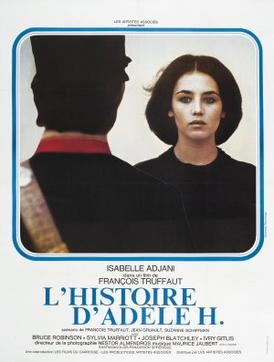
The Story of Adèle H. is a 1975 French historical drama film directed by François Truffaut, and starring Isabelle Adjani, Bruce Robinson, and Sylvia Marriott. Written by Truffaut, Jean Gruault, and Suzanne Schiffman, the film is about Adèle Hugo, the daughter of writer Victor Hugo, whose obsessive unrequited love for a military officer leads to her downfall. The story is based on Adèle Hugo's diaries. Filming took place on location in Guernsey and Senegal.
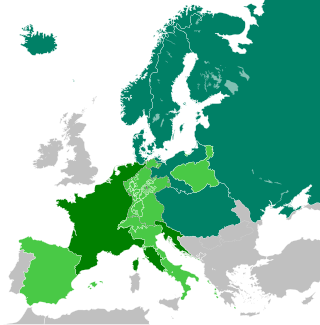
The Continental Blockade, or Continental System, was a large-scale embargo by Napoleon Bonaparte against the British Empire from 21 November 1806 until 11 April 1814, during the Napoleonic Wars. Napoleon issued the Berlin Decree on 21 November 1806 in response to the naval blockade of the French coasts enacted by the British government on 16 May 1806. The embargo was applied intermittently, ending on 11 April 1814 after Napoleon's first abdication.
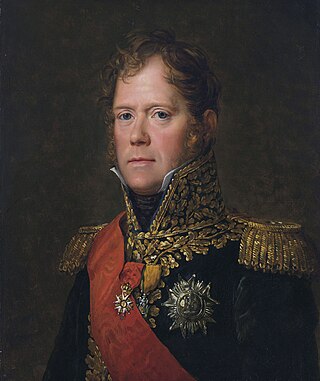
Michel Ney, 1st Duke of Elchingen, 1st Prince of the Moskva was a French military commander and Marshal of the Empire who fought in the French Revolutionary Wars and the Napoleonic Wars.

Le Devoir is a French-language newspaper published in Montreal and distributed in Quebec and throughout Canada. It was founded by journalist and politician Henri Bourassa in 1910.

Abel Gance was a French film director and producer, writer and actor. A pioneer in the theory and practice of montage, he is best known for three major silent films: J'accuse (1919), La Roue (1923), and Napoléon (1927).

The War of the Second Coalition was the second war on revolutionary France by most of the European monarchies, led by Britain, Austria, and Russia and including the Ottoman Empire, Portugal, Naples and various German monarchies. Prussia did not join the coalition, and Spain supported France.

Louis Antoine de Bourbon, Duke of Enghien was a member of the House of Bourbon of France. More famous for his death than his life, he was executed by order of Napoleon Bonaparte, who brought charges against him of aiding Britain and plotting against Napoleon.
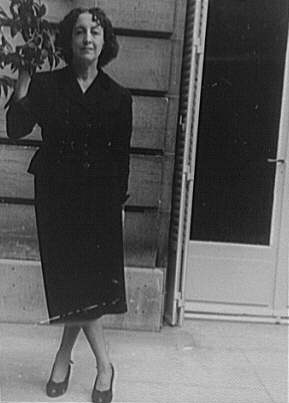
Marie-Laure Henriette Anne de Noailles, Vicomtesse de Noailles was a French artist, regarded one of the 20th century's most daring and influential patrons of the arts, noted for her associations with Salvador Dalí, Balthus, Jean Cocteau, Ned Rorem, Man Ray, Luis Buñuel, Francis Poulenc, Wolfgang Paalen, Jean Hugo, Jean-Michel Frank and others as well as her tempestuous life and eccentric personality. She and her husband financed Ray's film Les Mystères du Château de Dé (1929), Poulenc's Aubade (1929), Buñuel and Dalí's film L'Âge d'Or (1930), and Cocteau's The Blood of a Poet (1930).
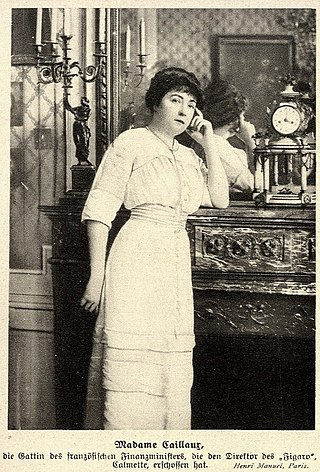
Henriette Caillaux was a Parisian socialite and second wife of the former Prime Minister of France, Joseph Caillaux. On March 16, 1914, she shot and killed Gaston Calmette, editor of the newspaper Le Figaro.
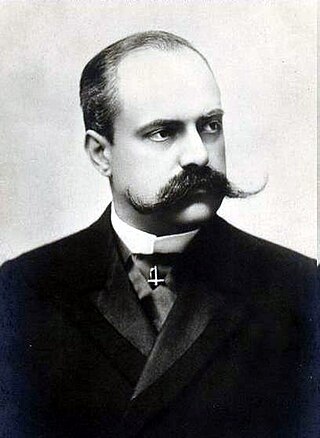
Victor, Prince Napoléon, titular 3rd Prince of Montfort, was the disputed Bonapartist pretender to the French throne from 1879 until his death in 1926. He was known as Napoléon V by those who supported his claim.
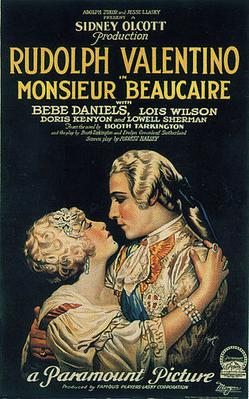
Monsieur Beaucaire is a 1924 American silent romantic historical drama film starring Rudolph Valentino in the title role, Bebe Daniels, and Lois Wilson. Produced and directed by Sidney Olcott, the film is based on Booth Tarkington's 1900 novel of the same name and the 1904 play of the same name by Tarkington and Evelyn Greenleaf Sutherland.

Dany Robin was a French actress of the 1950s and the 1960s.

Orphans of the Storm is a 1921 American silent drama film by D. W. Griffith set in late-18th-century France, before and during the French Revolution.

The Young Mr. Pitt is a 1942 British biographical film of the life of William Pitt the Younger and in particular his struggle against revolutionary France and Napoleon. It was directed by Carol Reed and stars Robert Donat, Robert Morley, Phyllis Calvert and John Mills. Made in black-and-white, it was produced by Edward Black and Maurice Ostrer for the British subsidiary of 20th Century Fox.
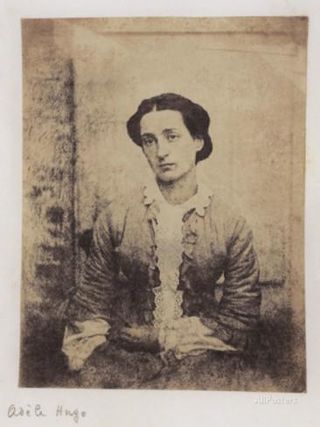
Adèle Hugo was the fifth and youngest child of French writer Victor Hugo. She is remembered for developing schizophrenia as a young woman, which led to a romantic obsession with a British military officer who rejected her. Her story has been retold in film and books, such as François Truffaut's 1975 film The Story of Adèle H.

Woman to Woman is a 1947 British drama film directed by Maclean Rogers and starring Douglass Montgomery, Joyce Howard and Adele Dixon. It is based on the 1921 play Woman to Woman by Michael Morton which had previously been made into films twice during the 1920s. A Canadian officer and a French dancer engage in a doomed romance.
References
- ↑ Parrill, William B. (2015-06-08). European Silent Films on Video: A Critical Guide. McFarland. ISBN 9781476610214.
- ↑ Kaplan, Nelly; Gance, Abel; Unit, British Film Institute African & Caribbean (1994). Napoleon. Macmillan. ISBN 9780851704661.
- ↑ Institute, British Film (2003). British Film Institute Film Classics. Taylor & Francis. ISBN 9781579583286.
- ↑ Powrie, Professor Phil (2005-01-18). Pierre Batcheff and Stardom in 1920s French Cinema. Edinburgh University Press. ISBN 9780748629602.